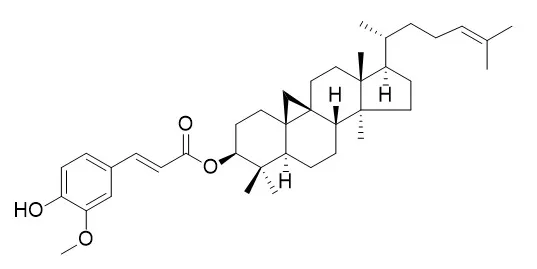| In vitro: |
| Phytomedicine . 2010 Feb;17(2):152-6 | | Cycloartenyl ferulate, a component of rice bran oil-derived gamma-oryzanol, attenuates mast cell degranulation[Pubmed: 19577449] | | IgE-targeting therapy could provide significant progress in the treatment of allergic inflammation. In this study, we examined the effect of Cycloartenyl ferulate (cycloartenol ferulic acid ester; CAF), a natural product from rice bran oil-derived gamma-oryzanol, on allergic reaction. When CAF and gamma-oryzanol were injected intradermally with anti-DNP IgE into the dorsal skin of rats, the passive cutaneous anaphylaxis reaction induced by DNP-HSA was attenuated. CAF and gamma-oryzanol also inhibited the degranulation of DNP-IgE sensitized RBL-2H3 mast cells stimulated with anti-DNP-HSA. IgE conjugated with CAF could not be detected by anti-IgE antibody in the ELISA analysis. Although incubation of IgE with CAF did not decrease the amount of IgE, it was possible to precipitate IgE by centrifugation. These results demonstrate that CAF captures IgE, prevents it from binding to FcepsilonRI, and attenuates mast cell degranulation. | | Food Chem . 2013 Nov 15;141(2):1000-7 | | Cycloartenyl trans-ferulate, a component of the bran byproduct of sake-brewing rice, inhibits mammalian DNA polymerase and suppresses inflammation[Pubmed: 23790879] | | During the screening of selective DNA polymerase (pol) inhibitors, we isolated cycloartenyl trans-ferulate (CAF), which is a major component of γ-oryzanol, which is a byproduct formed during the production of Japanese rice wine "sake". CAF selectively inhibited the activity of mammalian A, B, and X pol families, but Y family pols were not affected. CAF did not influence the activities of plant or prokaryotic pols, nor the activity of other DNA metabolic enzymes tested. Individual chemical components of CAF, including cycloartenol (CA) and ferulic acid (FA), did not inhibit pol enzyme activities. CAF suppressed TPA (12-O-tetradecanoylphorbol-13-acetate)-induced inflammation in the mouse ear, but CA and FA did not. The ability to inhibit mammalian pol enzymes in vitro was positively correlated with their propensity to suppress inflammation in vivo. These results suggest that this byproduct formed during the sake-brewing process is useful as an anti-inflammatory agent. | | Biochem Pharmacol . 2009 May 1;77(9):1487-96 | | A rice bran polyphenol, cycloartenyl ferulate, elicits apoptosis in human colorectal adenocarcinoma SW480 and sensitizes metastatic SW620 cells to TRAIL-induced apoptosis[Pubmed: 19426686] | | High intake of whole grain food has been suggested as an important factor for reducing the risk of colon cancer, owing to the abundance of indigestible fibers. Our findings demonstrated that, among various rice bran phenolic compounds tested, Cycloartenyl ferulate (CF) showed the most prominent in vitro growth inhibition on human colorectal adenocarcinoma SW480, but had low toxicity on normal colon CCD-18-Co cells. The anticancer activity of CF was further illustrated by its ability to induce significant regression of SW480 xenograft in nude mice. CF elevated the death receptors DR4 and DR5 and triggered both the death receptor and the mitochondrial apoptosis pathways. Depletion of anti-apoptotic Bcl-2 and up-regulation of pro-apoptotic Bak were observed, accompanied by dissipation of the mitochondrial membrane potential and release of cyto c and SMAC/DIABLO from mitochondria into the cytosol. Bid was found to be cleaved by caspase-8, so that the death receptor pathway might be exaggerated by the mitochondrial pathway. Strikingly, we showed for the first time that CF also sensitized the metastatic and resistant colon cancer SW620 to TRAIL-induced apoptosis and the mechanisms involved at least enhanced activation of caspase-8 and -3. This study provides a clear evidence that the health-beneficial properties of whole grain consumption are not only limited by the presence of dietary fibers but also other molecules that can either act as a chemopreventive agent to directly induce tumor regression or as a sensitizer to enhance TRAIL-induced apoptosis in metastatic cancer cells. | | Curr Top Med Chem . 2011;11(14):1847-53. | | Biological abilities of rice bran-derived antioxidant phytochemicals for medical therapy[Pubmed: 21506933] | | Rice bran contains important bioactive phytochemicals. Among these phytochemicals, steryl ferulates including γ-oryzanol and its major components such as Cycloartenyl ferulate (CAF), 24-methylenecycloartanyl ferulate (24-mCAF), β-sitosteryl ferulate (β-SF), and campesteryl ferulate have been intensively studied due to their crucial roles in pathological processes. On the basis of experimental studies published during the last decade in relation to antioxidant, anti-inflammatory, anti-ulcerogenic, hypolipidemic, anti-neoplastic, anti-diabetic, and anti-allergic phenomena, these bioactive phytochemicals are reviewed in this paper. Particularly, in vivo and in vitro studies have clarified that rice bran phytosteryl ferulates mediate anti-inflammatory effects by down-regulating the inflammatory transcription factor, nuclear factor κB (NF-κB), which in turn reduces expression of inflammatory enzymes such as COX-2 and iNOS, and proinflammatory cytokines such as IL-1β, IL-6 and TNF-α. Moreover, rice bran phytosteryl ferulates up-regulate blood adiponectin levels via indirect activation of peroxisomal proliferator-activated receptor γ (PPARγ) through NF-κB inhibition. In this review, we discuss potential pharmacological aspects of rice bran phytosteryl ferulates in the clinical setting. |
|






 Cell. 2018 Jan 11;172(1-2):249-261.e12. doi: 10.1016/j.cell.2017.12.019.IF=36.216(2019)
Cell. 2018 Jan 11;172(1-2):249-261.e12. doi: 10.1016/j.cell.2017.12.019.IF=36.216(2019) Cell Metab. 2020 Mar 3;31(3):534-548.e5. doi: 10.1016/j.cmet.2020.01.002.IF=22.415(2019)
Cell Metab. 2020 Mar 3;31(3):534-548.e5. doi: 10.1016/j.cmet.2020.01.002.IF=22.415(2019) Mol Cell. 2017 Nov 16;68(4):673-685.e6. doi: 10.1016/j.molcel.2017.10.022.IF=14.548(2019)
Mol Cell. 2017 Nov 16;68(4):673-685.e6. doi: 10.1016/j.molcel.2017.10.022.IF=14.548(2019)